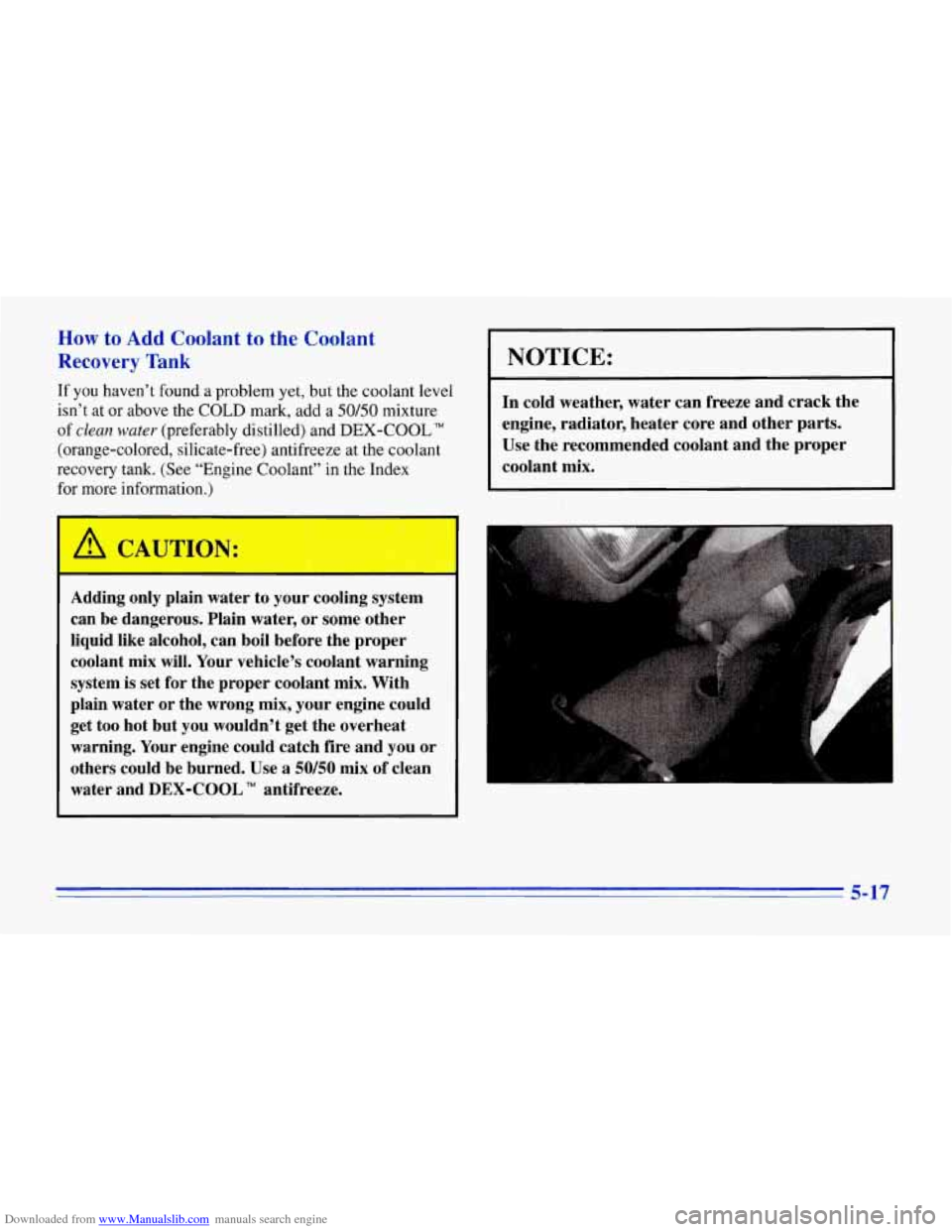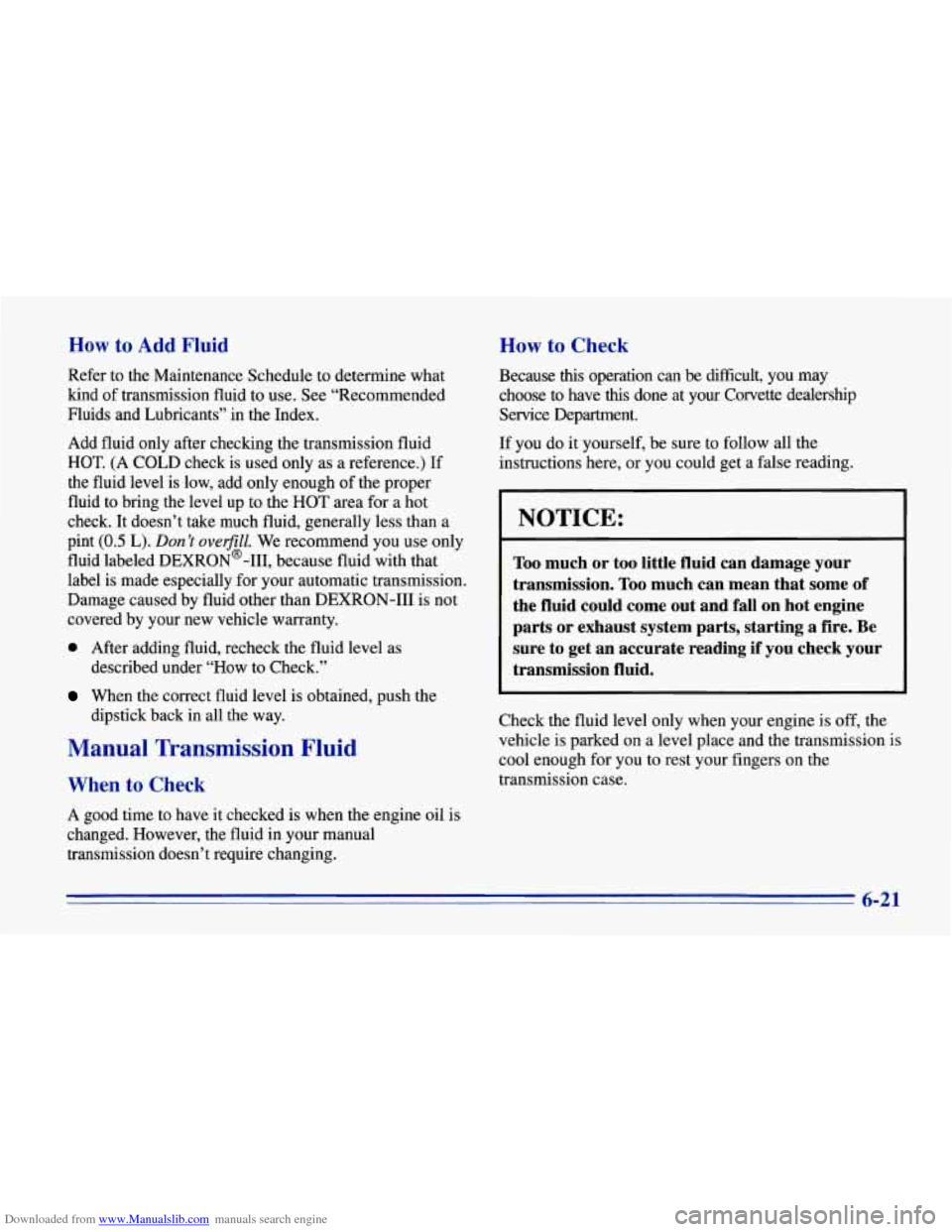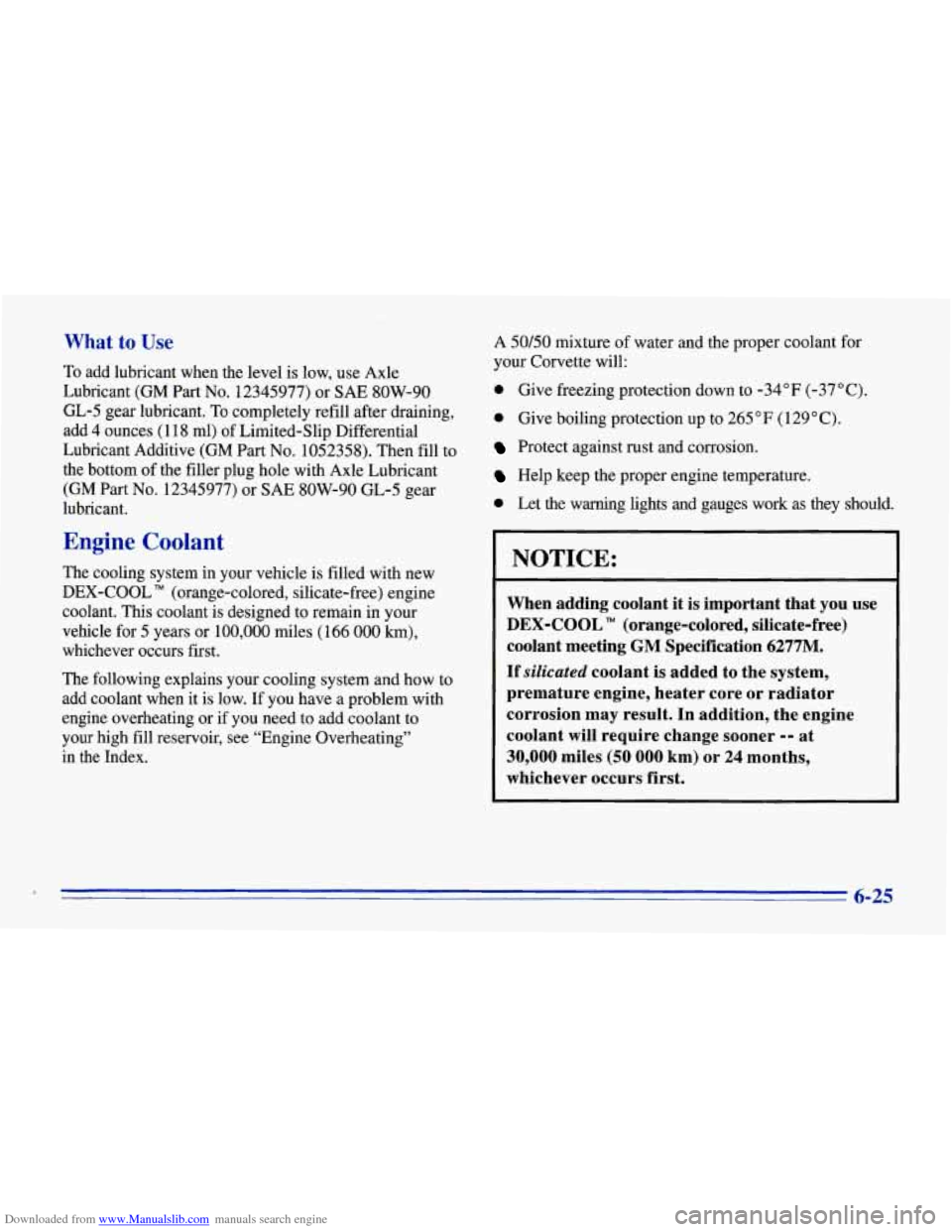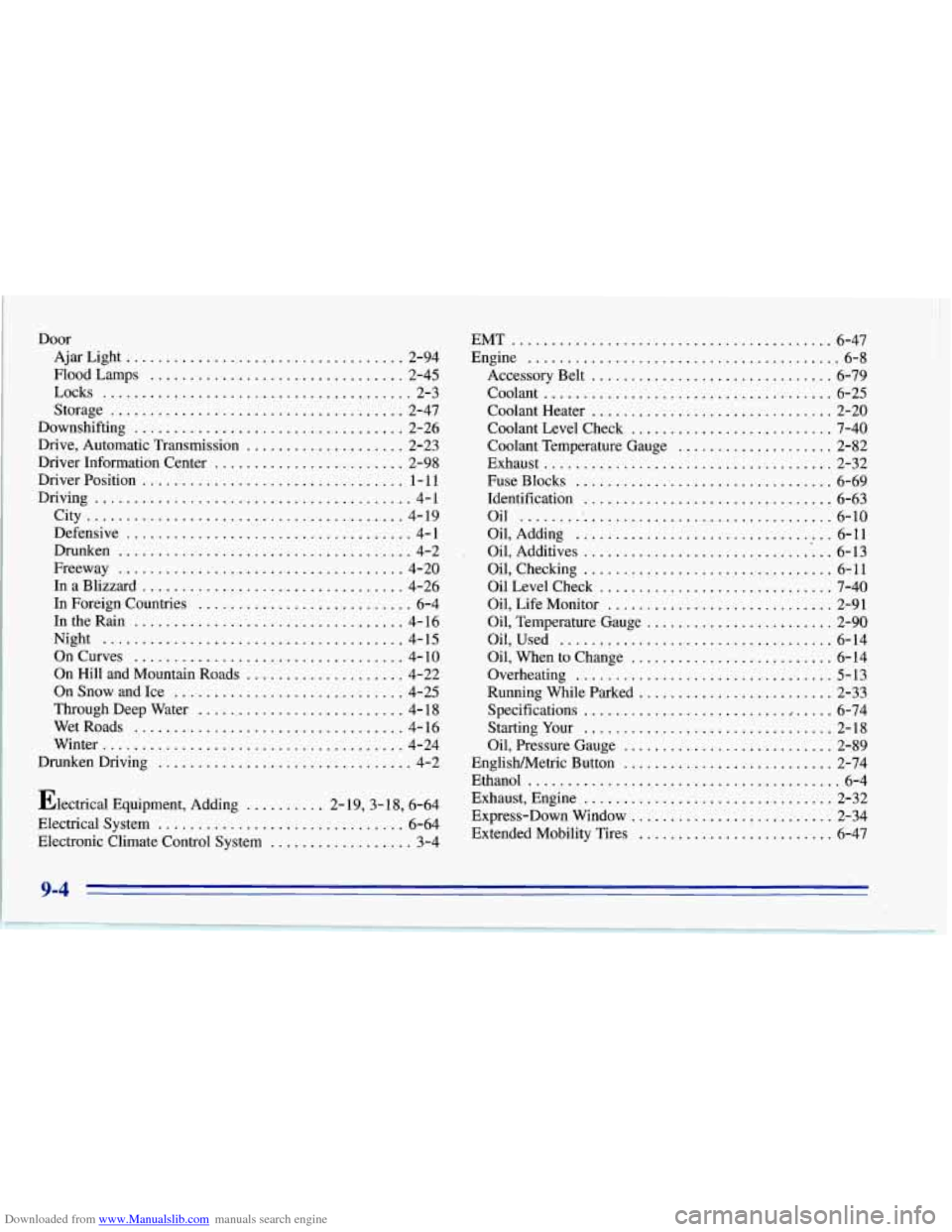1996 CHEVROLET CORVETTE adding oil
[x] Cancel search: adding oilPage 62 of 386

Downloaded from www.Manualslib.com manuals search engine START for about three seconds. If the vehicle starts
briefly but then stops again, do the same thing, but
this time keep the pedal down for five or six seconds.
This clears the extra gasoline from the engine.
I NOTICE:
Your engine is designed to work with the
electronics in your vehicle.
If you add electrical
parts or accessories, you could change the
way
the engine operates. Before adding electrical
equipment, check with your dealer.
If you don’t,
your engine might not perform properly.
If you ever have to have your vehicle towed, see
the part of this manual that tells how to do it
without damaging your vehicle. See “Towing
Your Vehicle” in the Index.
Racing or Other Competitive Driving
See your Warranty Book before using your Corvette for
racing or other competitive driving.
NOTICE:
If you use your Corvette for racing or other
competitive driving, your engine may use more
oil than it would with normal use. Low oil levels
can damage the engine. Be sure to check the oil
level often during racing or other competitive
driving and keep the level at or near the upper
mark on the engine oil dipstick.
You may need to
add oil. See “Engine Oil” in the Index.
2-19
Page 208 of 386

Downloaded from www.Manualslib.com manuals search engine How to Add Coolant to the Coolant
Recovery Tank
If you haven’t found a problem yet, but the coolant level
isn’t at
or above the COLD mark, add a 50/50 mixture
of
clean water (preferably distilled) and DEX-COOL“
(orange-colored, silicate-free) antifreeze at the coolant
recovery tank. (See “Engine Coolant” in the Index
for more information.)
-
A CAUTION:
Adding only plain water to your cooling system
can be dangerous. Plain water, or some other
liquid like alcohol, can boil before the proper
coolant
mix will. Your vehicle’s coolant warning
system is set for the proper coolant mix. With
plain water or the wrong mix, your engine could
get too hot but you wouldn’t get the overheat
warning.
Your engine could catch fire and you or
others could be burned. Use
a 50/50 mix of clean
water and
DEX-COOL TM antifreeze.
NOTICE:
In cold weather, water can freeze and crack the
engine, radiator, heater core and other parts.
Use the recommended coolant and the proper
coolant mix.
5-17
Page 244 of 386

Downloaded from www.Manualslib.com manuals search engine SAE 5W-30
As shown in the viscosity chart, SAE 5W-30 is best
for your vehicle. However, you can use
SAE
1OW-30 if it’s going to be 0°F (-18°C) or above.
These numbers
on an oil container show its viscosity,
or thickness. Do not use other viscosity oils such as
SAE 20W-50.
Oils meeting these
requirements should also
have the “Starburst”
symbol on the container.
This symbol indicates that
the oil has been certified
by the American Petroleum
Institute (API).
Do not use
any oil which does not
carry this Starburst symbol.
You should look for this on the oil container, and use
only those oils that are identified as meeting GM
Standard GM4718M and have the Starburst symbol on
the front of the oil container. Your
Corvette engine is filled at the factory with a
Mobil 1
@ synthetic oil, which meets all requirements
for your vehicle.
Substitute Oil: When adding oil to maintain engine
oil level, oil meeting GM Standard GM47 18M may
not be available. You can add substitute oil designated
SAE 5W-30 with the “Starburst” symbol at all
temperatures.
If temperatures are above 0” F (- 18 ” C),
you may substitute SAE 1OW-30 with the “Starburst”
symbol. Substitute oil not meeting GM Standard
GM47 18M should not be used for an oil change.
Engine Oil Additives
Don’t add anything to your oil. Your Corvette dealer is
ready to advise
if you think something should be added.
6-13
Page 252 of 386

Downloaded from www.Manualslib.com manuals search engine How to Add Fluid
Refer to the Maintenance Schedule to determine what
kind of transmission fluid to use. See “Recommended
Fluids and Lubricants” in the Index.
Add fluid only after checking the transmission fluid
HOT.
(A COLD check is used only as a reference.) If
the fluid level is low, add only enough of the proper
fluid to bring the level up to the
HOT area for a hot
check. It doesn’t take much fluid, generally less than a
pint
(0.5 L). Don’t overfill. We recommend you use only
fluid labeled DEXRON@-111, because fluid with that
label is made especially for your automatic transmission.
Damage caused by fluid other than DEXRON-I11 is not
covered by your new vehicle warranty.
0 After adding fluid, recheck the fluid level as
described under “How to Check.”
When the correct fluid level is obtained, push the
dipstick back in all the way.
Manual Transmission Fluid
When to Check
A good time to have it checked is when the engine oil is
changed. However, the fluid in your manual
transmission doesn’t require changing.
How to Check
Because this operation can be difficult, you may
choose to have
this done at your Corvette dealership
Service Department.
If you do it yourself, be sure to follow all the
instructions here, or you could get a false reading.
NOTICE:
Too much or too little fluid can damage your
transmission.
Too much can mean that some of
the fluid could come out and fall on hot engine
parts or exhaust system parts, starting a fire. Be
sure to get an accurate reading
if you check your
transmission fluid.
Check the fluid level only when your engine is off, the
vehicle is parked on a level place and the transmission
is
cool enough for you to rest your fingers on the
transmission case.
6-21
Page 256 of 386

Downloaded from www.Manualslib.com manuals search engine What to Use
To add lubricant when the level is low, use Axle
Lubricant (GM
Part No. 12345977) or SAE SOW-90
GL-5 gear lubricant.
To completely refill after draining,
add 4 ounces
(1 18 ml) of Limited-Slip Differential
Lubricant Additive (GM Part
No. 1052358). Then fill to
the bottom
of the filler plug hole with Axle Lubricant
(GM
Part No. 12345977) or SAE SOW-90 GL-5 gear
lubricant.
Engine Coolant
The cooling system in your vehicle is filled with new
DEX-COOL (orange-colored, silicate-free) engine
coolant. This coolant is designed
to remain in your
vehicle for
5 years or 100,000 miles (166 000 km),
whichever occurs first.
The following explains your cooling system and how
to
add coolant when it is low. If you have a problem with
engine overheating or
if you need to add coolant to
your high fill reservoir, see “Engine Overheating”
in the Index.
A 50/50 mixture of water and the proper coolant for
your Corvette will:
0 Give freezing protection down to -34°F (-37°C).
0 Give boiling protection up to 265 OF ( 129 O C).
Protect against rust and corrosion.
Help keep the proper engine temperature.
0 Let the warning lights and gauges work as they should.
NOTICE:
When adding coolant it is important that you use
DEX-COOL (orange-colored, silicate-free)
coolant meeting GM Specification 6277M.
If
silicated coolant is added to the system,
premature engine, heater core or radiator
corrosion may result. In addition, the engine
coolant will require change sooner
-- at
30,000 miles (50 000 km) or 24 months,
whichever occurs first.
6-25
Page 257 of 386

Downloaded from www.Manualslib.com manuals search engine What to Use
Use a mixture of one-half clean water (preferably
distilled) and one-half
DEX-COOL TM (orange-colored,
silicate-free) antifreeze that meets GM Specification
6277M, which won’t damage aluminum parts. Use
GM Engine Coolant Supplement (sealer) (GM
Part
No. 3634621) with any complete coolant change. If you
use this mixture, you don’t need to add anything else.
Adding only plain water to your cooling system
can be dangerous. Plain
water, or some other
liquid like alcohol, can boil before the proper
coolant mix will. Your vehicle’s coolant warning
system is set for the proper coolant mix. With
plain water or the wrong mix, your engine could
get too hot but you wouldn’t get the overheat
warning. Your engine could catch fire and
you or
others could be burned. Use
a 50/50 mix of clean
water and
DEX-COOL TM (orange-colored.
silicate-free) antifreeze.
NOTICE:
If you use an improper coolant mix, your engine
could overheat and be badly damaged. The
repair cost wouldn’t be covered by your
warranty. Too much water in the
mix can freeze
and crack the engine, radiator, heater core and
other parts.
If you have to add coolant more than four times a year,
have your dealer check your cooling system.
NOTICE:
If you use the proper coolant, you don’t have to
add extra inhibitors or additives which claim to
improve the system. These can be harmful.
.
Page 377 of 386

Downloaded from www.Manualslib.com manuals search engine Door AjarLight
................................... 2-94
Flood Lamps
................................ 2-45
Downshifting
.................................. 2-26
Drive, Automatic Transmission
.................... 2-23
Driver Information Center
........................ 2-98
DriverPosition
................................. 1-11
Driving
........................................ 4-1
Defensive
.................................... 4-1
Drunken ..................................... 4-2
Freeway
.................................... 4-20
InaBlizzard
................................. 4-26
In Foreign Countries ......................... . 6-4
IntheRain
.................................. 4-16
Night
...................................... 4-15
On Curves ................................... 4- 10
On Hill and Mountain Roads
.................... 4-22
On Snow and Ice
............................. 4-25
Through Deep Water
.......................... 4- 18
WetRoads
.................................. 4-16
Winter
...................................... 4-24
Drunken Driving
................................ 4-2
Locks
....................................... 2-3
Storage
..................................... 2-47
City
........................................ 4-19
Electrical Equipment, Adding
.......... 2-19,3-18, 6-64
Electrical System
............................... 6-64
Electronic Climate Control System
.................. 3-4 EMT
......................................... 6-47
Engine
........................................ 6-8
Accessory Belt
............................... 6-79
Coolant
..................................... 6-25
Coolant Heater
............................... 2-20
Coolant Level Check
.......................... 7-40
Coolant Temperature Gauge
.................... 2-82
Exhaust
..................................... 2-32
FuseBlocks
................................. 6-69
Identification
................................ 6-63
Oil
......................................... 6-10
Oil, Adding
................................. 6-11
Oil, Additives
................................ 6-13
OilLevelCheck
.............................. 7-40
Oil. Checking
................................ 6-11
Oil, Life Monitor
............................. 2-91
Oil, Temperature Gauge
........................ 2-90
Oil, Used
................................... 6-14
Oil, When to Change
.......................... 6-14
Running While Parked
......................... 2-33
Specifications
................................. 6-74
Oil, Pressure Gauge
........................... 2-89
EnglishMetric Button
........................... 2-74
Ethanol
........................................ 6-4
Exhaust, Engine
................................ 2-32
Express-Down Window
............... .......... 2-34
Overheating
................................. 5-13
StartingYour ................................ 2-18
Extended Mobility Tires
......................... 6-47